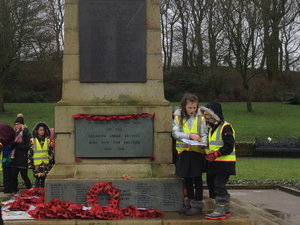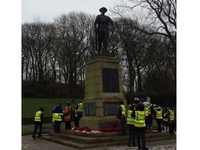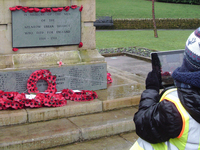- County name: Greater Manchester
- Group/School name: Moorhouse Primary School
- Age group: 5 - 11
- Group type: Year 5
As part of a project organised by Historic England's Heritage Schools Programme, War Memorials Trust’s Learning Officer arranged to visit Moorhouse Primary School in Rochdale at the end of January 2019. The year 5 class had begun a World War I topic at the start of the spring term and had already looked at some of the basic causes of World War I, impact on the population, propaganda and conscription. The visit provided an opportunity for pupils to understand more about the impact on the local area by looking at the war memorial.
Due to the adverse weather expected during course of the visit, the schedule for the morning was reordered slightly to try and avoid visiting the war memorial while it was sleeting and snowing. Initially the pupils were asked to consider what a war memorial is and try to create a simple definition. Through discussion and by looking at images pupils were successful in this task and established that war memorials came in a range of designs and were created to commemorate those who had fought or died in wars.
Following this, it was explained to pupils that they would be visiting their local war memorial in Milnrow to carry out a condition survey. The different roles which would be undertaken by the three groups of children were explained before setting off. Upon arriving at the war memorial, pupils were able to identify that it commemorated the fallen from both the First and Second World Wars. As the sleet worsened, pupils diligently carried out the condition survey. Some focused on the stone and metalwork, others on the inscriptions and names while the final group assessed the area around the war memorial. Each group had a photographer assigned to it so that photographs could be taken to provide evidence of observations made.
Back in the classroom each group shared the observations they had made with the rest of the class as well as the condition level they had awarded. With Good being awarded by two groups and Fair by the third, it was decided that the memorial should be given an overall condition level of Good. This condition update was uploaded to War Memorials Online, www.warmemorialsonline.org.uk/report/168512/view/condition/208073. It was noted that the previous condition survey had been carried out in March 2014 so pupils were delighted that they were able to provide an update almost five years on. Photographs taken by the pupils (including the soldier statue and the name plaques) were added to the main record, www.warmemorialsonline.org.uk/memorial/168512.
The rest of the morning was spent finding out more about war memorials. Pupils were shown images of a variety of war memorials in the local area including a Boer War memorial in memory of the Men and Sisters of Rochdale to reinforce that there are war memorials commemorate those who fought in wars other than the First and Second World War. When looking at Milnrow war memorial it was revealed that it has not always been located in the park, where pupils saw it earlier on. When it was erected in August 1924, it was positioned at the Kiln Lane end of Dale Street, set back from edge of the road near Milnrow Bridge. The memorial was moved to the park in 1951 due to road improvement works which saw the widening of Bridge Street and Dale Street. Next pupils were asked to consider how many war memorials there are in the UK and when these were created.
The final discussion centred on why war memorials were created, particularly in the wake of the First World War. Pupils were able to identify that it was important to remember those who had fought and died. In addition, pupils discussed that the fallen were buried near where they fell on the battlefield which meant family and friends had a need for a place locally where they could remember their loved ones. To highlight that the fallen were not repatriated, pupils were shown the CWGC cemeteries where two men named on the war memorial in Milnrow were buried. Private Binton Hollows was buried in Turkey and Private Albert Irving McDougall was buried in France. It was understood that both locations could prove difficult for relatives to travel to. Yet the parents of both men lived less than a ten minute walk from the original location of the war memorial and therefore it was somewhere they could visit on a regular basis if they wished.
Future work for the children will include researching those named on the war memorial so that they have a better understanding of those who lived locally 100 years ago.
The visit was very successful despite the challenging weather and freezing temperatures that were encountered when visiting the war memorial. Pupils were still able to carry out a condition survey, upload this to War Memorials Online and also gain a better understanding of why a war memorial was erected in Milnrow.





